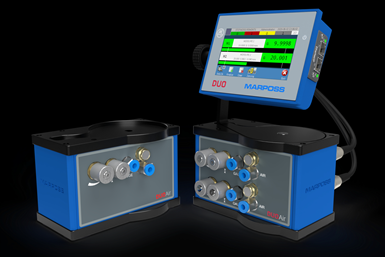Marposs Introduces Air Gage Interface Box for Data Acquisition
The Duo Air can be supplied with one or two analog air-to-electronics converters with adjustable sensitivity and zeroing nozzles for connecting to one or two gauges.
Share




Marposs, a leader in measurement, inspection and test technologies, announces its new Duo Air interface box for easy and economical management of a wide range of air gauges. The Duo Air can be supplied with either one or two analog air-to-electronics converters with adjustable sensitivity and zeroing nozzles for connecting to one or two gauges. Each converter provides a linear variable differential transformer (LVDT) output signal for easy association to the Marposs’ Duo electronic display unit, offering a compact and affordable solution for measurement applications. Duo Air is said to be ideal for measurements with small tolerances requiring high resolution of 0.1 µm.
According to Marposs, the Duo Air is accurate, robust and versatile, with the ability to accept air gauges from other manufacturers. Both Marposs and non-Marposs air gauges can be easily and immediately connected to Duo Air, with consideration to the following parameters:
- Air supply pressure (3 bar ± 0.1)
- Number of air gauge jets
- Diameter of air gauge jets
- “Mid-range gap”; the difference between the mid-tolerance diameter of the part to be measured and the distance between the air gauge jets
In a typical application, the Duo Air reportedly offers linearity of < 0.4% of the working range, repeatability of < 0.15 µm, noise of <0.1µm, resolution of 0.01 µm and a response time of 200 milliseconds.
Related Content
-
Four Questions (& Answers) About Data-Driven Process Improvement at CNC Job Shops
How can shops can make informed decisions using data-driven feedback to improve shopfloor efficiency and profitability? And how will these technologies differ between high- and low-volume production?
-
Reinventing a Precision Shop With a Data-Driven Mindset
When this machine shop lost 90% of its business within three months, a reinvention was in order. Here's how it survived after quickly falling on hard times.
-
Diving Deeper Into Machine Monitoring Data
Data visualization is the first step in using machine monitoring data, but taking it to the next level requires looking for trends within the data.



















.jpg;maxWidth=300;quality=90)



